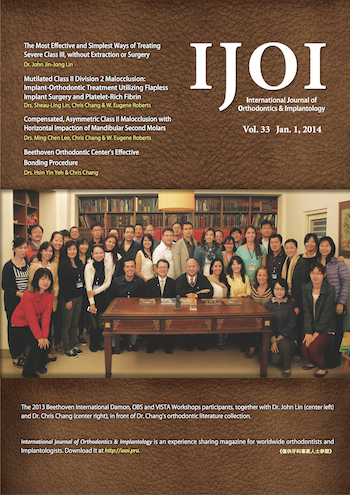IJOI Vol. 33

The Most Effective and Simplest Ways of Treating Severe Class III, without Extraction or Surgery
Lin JJ
Mutilated Class II Division 2 Malocclusion: Implant-Orthodontic Treatment Utilizing Flapless Implant Surgery and Platelet-Rich Fibrin
Lin SL, Chang CH, Roberts WE
SUMMARY
This severe mutilated Class II malocclusion (DI=36) in a adult female was managed with combined orthodontics and implant-supported prostheses. The upper right 1st molar and hopeless lower right 2nd molar were extracted, and the adjacent 2nd or 3rd molars were moved mesially to close the space. The missing left upper 1st molar was restored with a apless implant procedure, to preserve available bone and soft tissue. Although there was a modest compromise in the buccal interdigitation, this interdisciplinary approach resulted in an excellent, cost e ective improvement in occlusal function (CRE+20) and dental esthetics (P&I=3). (Int J Orthod Implantol 2014;33:22-47)
Key words: Deep bite, atypical extractions, implant-supported prosthesis, apless implant surgery, platelet-rich brin (PRF)
Download Article
Compensated, Asymmetric Class II Malocclusion with Horizontal Impaction of Mandibular Second Molars
Lee MC, Chang CH, Roberts WE
History and Etiology
A 19-year-10-month-old male presented for orthodontic consultation with chief complaints of delayed eruption of mandibular molars, poor masticatory function and irregular dentition. He was previously advised by several orthodontists that extraction of the bilateral impacted lower second molars and replacement with dental implants was the only viable option for correcting his malocclusion with facial asymmetry (Figs. 1-3). There were no contributing medical, dental or family histories. Because it was bilateral, the etiology of the malocclusion appears to be a genetically-related aberrant path of eruption or ectopic position(s) of developing teeth. This difficult malocclusion was treated to an optimal result, as documented in Figs. 4-6. (Int J Orthod Implantol 2014;33:50-65)
Treatment of Bimaxillary Protrusion, Blocked-Out Canine and Buccal Crossbite
Huang YH, Chang CH, Roberts WE
History and Etiology
A 24-year-and-8-month-old female presented for orthodontic treatment (Figs. 1-3). Her chief complaints were protrusive profile and high (blocked-out) canine. There were no known history or habits contributing to the malocclusion. The clinical examination revealed a relatively long face with a steep mandibular plane angle and a tooth- size to arch-length discrepancy in both arches. This pattern suggests the malocclusion is primarily an environmental problem associated with relatively low biting strength associated with a history of less intensive masticatory loading. (Int J Orthod Implantol 2014;33:66-87)
Management of Anterior Cross Bite, Severe Crowding and Loss of a Lower First Molar by Utilizing a Horizontally Impacted Third Molar
Lee J, Chang CH, Roberts WE
History and Etiology
A 23 year old female presented for a consultation about crowding and crossbite of her anterior teeth, as well the impending loss of the lower right first molar (Figs. 1-3). She had obtained previous orthodontic consultations but was dissatisfied because none of the treatment plans focused on recovering her lower right impacted third molar (#32) and aligning it in the quadrant to replace the hopeless rst molar. There was no other contributing dental or medical history. (Int J Orthod Implantol 2014;33:88-100)
Beethoven Orthodontic Center’s Effective Bonding Procedure
Yeh HY, Chang CH
Introduction
Bonding signifies the beginning of orthodontic treatment. The precision of bonding dictates the efficiency and final quality of treatment and therefore, it is an important issue that we should consider with great care. Beethoven Orthodontic Clinic has adopted Damon® bracket system (Ormco) since 2005, and we keep on improving our treatment quality by routine case analysis. Now Beethoven Orthodontic Center has established a set of standard protocols which can make this important beginning more effective and achieve ideal treatment results. (Int J Orthod Implantol 2014;33:102-108)